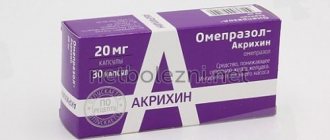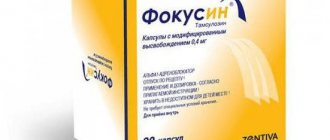Emanera®
Effect of esomeprazole on the pharmacokinetics of other drugs
Drugs whose absorption depends on pH levels
A decrease in the secretion of hydrochloric acid in the stomach during treatment with esomeprazole and other PPIs can lead to changes in the absorption of drugs, the absorption of which depends on the level of acidity of the environment. Like antacids and other drugs that reduce gastric acidity, esomeprazole may reduce the absorption of ketoconazole, itraconazole and erlotinib.
and increasing the absorption of drugs such as
digoxin.
Concomitant use of omeprazole 20 mg once daily and digoxin
increases the bioavailability
of digoxin
by 10% (bioavailability
of digoxin
increased by up to 30% in two out of ten patients).
Omeprazole is known to interact with some antiviral drugs.
The mechanism and clinical significance of these interactions are not always known.
A decrease in gastric acidity during omeprazole therapy may affect the absorption of antiviral drugs.
Interaction at the level of the CYP2C19 isoenzyme is also possible.
During therapy with omeprazole, there is a decrease in the serum concentrations of some antiviral drugs (atazanavir and nelfinavir).
Therefore, simultaneous use is contraindicated.
Concomitant use of omeprazole (40 mg once daily) with atazanavir
300
mg/ritonavir
100 mg in healthy volunteers is accompanied by a marked decrease in the bioavailability of atazanavir (AUC, Cmax and minimum concentration [Cmin] in plasma decreased by approximately 75%).
Increasing the atazanavir
to 400 mg did not compensate for the effect of omeprazole on the bioavailability
of atazanavir.
When omeprazole is used concomitantly with saquinavir
of saquinavir
increases .
Given the similar pharmacokinetic and pharmacodynamic properties of omeprazole and esomeprazole, the simultaneous use of esomeprazole with antiviral drugs such as atazanavir and nelfinavir,
contraindicated.
Drugs metabolized by the
CYP2C19 isoenzyme
CYP2C19 of esomeprazole metabolism. Thus, with simultaneous use of esomeprazole with drugs whose metabolism involves the CYP2C19 isoenzyme, such as diazepam, citalopram, imipramine, clomipramine, phenytoin
etc., the concentration of these drugs in the blood plasma may increase and, accordingly, a reduction in their dose may be required.
This especially needs to be taken into account when prescribing Emanera® in the on-demand mode. Thus, when used simultaneously with 30 mg of esomeprazole, the clearance of diazepam
(CYP2C19 isoenzyme substrate) by 45%.
Concomitant use of esomeprazole at a dose of 40 mg leads to an increase in phenytoin
in the blood plasma of patients with epilepsy by 13%. It is recommended to monitor plasma concentrations of phenytoin when initiating esomeprazole therapy and when discontinuing it.
When using omeprazole at a dose of 40 mg, the Cmax and AUC of voriconazole
(CYP2C19 isoenzyme substrate) by 15% and 41%, respectively.
Coagulation time with simultaneous long-term use of warfarin
and esomeprazole at a dose of 40 mg remains within acceptable limits.
However, a few cases of clinically significant increases in the international normalized ratio (INR) have been reported. It is recommended to monitor the INR at the beginning and at the end of concomitant use of esomeprazole and warfarin or other coumarin derivatives.
The use of omeprazole at a dose of 40 mg led to an increase in Cmax and AUC of cilostazol
by 18% and 26%, respectively; for one of the active metabolites
of cilostazol
, the increase was 29% and 69%, respectively.
Concomitant use of esomeprazole 40 mg with cisapride
leads to an increase in the values of the pharmacokinetic parameters of cisapride in healthy volunteers: AUC - by 32% and T1/2 - by 31%, but Cmax does not change significantly. The slight prolongation of the QT interval on the ECG, which is observed with cisapride monotherapy, was not increased by the addition of esomeprazole.
Some patients experienced increased concentrations of methotrexate
in blood serum during simultaneous use with PPIs. When using high doses of methotrexate, the possibility of temporary withdrawal of esomeprazole should be considered.
Esomeprazole does not cause clinically significant changes in the pharmacokinetics of amoxicillin and quinidine.
Concomitant short-term use of esomeprazole and naproxen or rofecoxib
did not reveal a clinically significant pharmacokinetic interaction. Results obtained from studies in healthy volunteers demonstrated a pharmacokinetic/pharmacodynamic interaction between clopidogrel (loading dose 300 mg/maintenance dose 75 mg per day) and esomeprazole (40 mg per day when administered orally), which leads to a decrease in systemic exposure of the active metabolite clopidogrel by an average of 40% and a decrease in the maximum suppression of (ADP-induced) platelet aggregation by an average of 14%.
When clopidogrel was used simultaneously with a fixed combination of 20 mg esomeprazole/81 mg acetylsalicylic acid (ASA), compared with the use of clopidogrel alone, in a study involving healthy volunteers, a decrease in systemic exposure to the active metabolite of clopidogrel was observed by almost 40%. However, the maximum levels of inhibition of (ADP-induced) platelet aggregation in these healthy volunteers were similar in the clopidogrel and clopidogrel fixed combination (esomeprazole/ASA) groups.
Both observational and clinical studies have provided conflicting data regarding the clinical consequences of the pharmacokinetic/pharmacodynamic interaction of esomeprazole on major cardiovascular events. As a precaution, concomitant use of clopidogrel should be avoided.
When used simultaneously with tacrolimus
increased serum concentrations
of tacrolimus are possible.
Effect of drugs on the pharmacokinetics of esomeprazole
The isoenzymes CYP2C19 and CYP3A4 are involved in the metabolism of esomeprazole.
With simultaneous use of esomeprazole with clarithromycin (500 mg 2 times a day) (inhibitor of the CYP3A4 isoenzyme), the AUC value of esomeprazole increases by 2 times.
Concomitant use of esomeprazole and a combined inhibitor of CYP2C19 and CYP3A4 isoenzymes (for example, voriconazole)
may be accompanied by an increase in the AUC of esomeprazole by more than 2 times. Usually in such situations no change in the dose of esomeprazole is required. In patients with severely impaired liver function or if long-term therapy is necessary, the issue of reducing the dose of esomeprazole should be considered.
Drugs that induce CYP2C19 and CYP3A4 isoenzymes, such as rifampicin and St. John's wort preparations, when used simultaneously with esomeprazole, may lead to a decrease in the concentration of esomeprazole in the blood plasma by accelerating the metabolism of esomeprazole.
Compatibility of Emanera and alcohol
? When consuming a single dose of alcohol, dyspeptic reactions may occur in the form of nausea, vomiting, and stool disturbances.
If the patient constantly neglects the prohibition received from the doctor, the following actions will occur:
- increased gas formation, leading to severe pain in the epigastric region;
- lack of therapeutic effect of the drug with exacerbation or relapse of reflux esophagitis;
- a gradual increase in the inflammatory reaction in the stomach, which appears due to exposure to toxic ethanol, which leads to the formation of ulcers and erosion of the stomach and duodenum;
- disruption of the microflora in the stomach, which leads to the active proliferation of the bacterium Helicobacter pylori, which causes peptic ulcers.
As ethyl alcohol accumulates in the tissues, the patient’s condition worsens. Therefore, simultaneous intake of alcohol and Emanera is prohibited.
Contraindications
The product has contraindications that must be taken into account before treatment:
- It is prohibited to use Atazanavir or Nelfinavir tablets together with Emanera.
- Children under 12 years of age should not use the drug. The thing is that there is not enough information about the effect for children.
- Use in children over 12 years of age is possible only for the diagnosis of GERD.
- Do not use if you are hypersensitive to the components of the drug.
Organs affected by the toxin
The combined use of pharmacological agents and alcohol has a toxic effect on the internal organs and environments of the body. Alcohol, entering into a chemical reaction with a medicine, leads to poisoning, disrupts physiological processes, enhances or weakens the healing properties of drugs.
The liver suffers more than other organs. She gets hit twice. Many medications have a side effect - hepatotoxicity, destroy cells, and disrupt the physiology of the organ. In the liver, alcohol breaks down to ethanal, a substance 20-30 times more toxic than ethanol, which causes the death of hepatocytes.
Dangerous groups of drugs for the organ in combination with alcohol:
- anti-inflammatory;
- hormonal;
- antibacterial;
- antifungal;
- glucose control agents for diabetes mellitus;
- anti-tuberculosis;
- cytostatics (chemotherapy drugs);
- tranquilizers (anti-epileptic, psychotropic).
In second place among the internal organs exposed to the harmful effects of alcohol together with medications are the heart and vascular system. Strong drinks during drug therapy constrict blood vessels and increase blood pressure. The simultaneous intake of alcohol and chemical substances leads to failure of the myocardium and increases the risk of developing an attack of angina pectoris and a heart attack.
A mixture of ethanol and pharmaceuticals disrupts the quality of the blood and reduces clotting. This is dangerous due to internal bleeding and strokes.
Use of the drug for alcoholism
Alcoholism leads to disruption of internal organs and systems. The initial impact falls on the liver. Alcoholic hepatitis forms, which transforms into fibrosis and cirrhosis. Chronic alcoholics are often diagnosed with liver malignancy.
Ethanol has a toxic effect on the walls of the digestive tract if the dosage is constantly exceeded. Therefore, gastritis and ulcers form.
The instructions for use of the medicine say that it is used with caution for liver diseases. This is due to the fact that the active substance of the drug is metabolized by the liver, and therefore affects it.
If you start therapy during alcoholism, the therapeutic effect of the drug is reduced. Ethanol acts on the kidneys, causing increased diuresis. The medicine is eliminated along with the urine, which reduces the therapeutic effect.
The most dangerous combinations and consequences
The combination of alcohol and chemical-based drugs can lead to serious disorders in the body, and in some cases to fatal consequences.
List of medications and their side effects in combination with alcohol:
| Name of group, drug | Negative results of interaction |
| Neuroleptics (tranquilizers, anticonvulsants, hypnotics) | Severe intoxication, up to cerebral coma |
| CNS stimulants (Theophedrine, Ephedrine, Caffeine) | Rapid increase in blood pressure, hypertensive crisis |
| Antihypertensives (Captofrin, Enalapril, Enap-N), diuretics (Indapamide, Furosemide) | Sudden drop in pressure, collapse |
| Analgesics, anti-inflammatory | Increased toxic substances in the blood, general poisoning of the body |
| Acetylsalicylic acid (Aspirin) | Acute gastritis, perforation of gastric ulcer and 12-PC |
| Paracetamol | Toxic liver damage |
| Hypoglycemic (Glibenclamide, Glipizide, Metformin, Phenformin), insulin | A sharp decrease in blood sugar levels, hypoglycemic coma |
Consequences of drinking alcohol
All patients are prohibited from drinking alcohol before starting treatment.
But if they break the rule, the following consequences arise:
- active diuresis, which removes the drug in a high volume along with urine, eliminating the effect of treatment;
- the formation of dyspeptic disorders that worsen the patient’s well-being;
- a high risk of developing allergic reactions that aggravate a person’s well-being if he suffers from itching caused by alcoholic hepatitis;
- active proliferation of bacteria in the stomach, gradually leading to the formation of ulcers with periods of bleeding;
- the appearance of vomiting, along with which the medicine leaves the stomach (vomiting worsens a person’s well-being with reflux esophagitis).
To eliminate the consequences, stop drinking alcohol in a timely manner. To continue drug therapy, consult a doctor.
When can you take the drug, after how long
How long after you can take the medicine is decided by your doctor after a general examination and laboratory tests. If a small amount of ethanol is concentrated in a person’s blood due to a single or periodic intake of alcohol, therapy is allowed to be carried out 2-3 days after consuming the last dose.
If the patient is an alcoholic, it is not recommended to begin treatment until the addiction is completely eliminated. If a person refuses alcohol, therapy is carried out no earlier than after 4-5 weeks.


